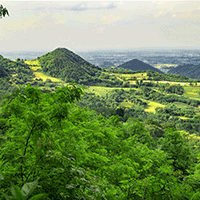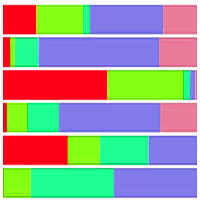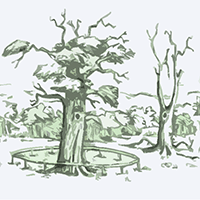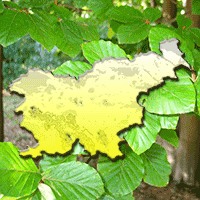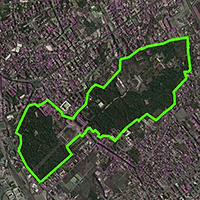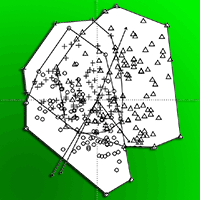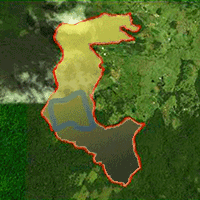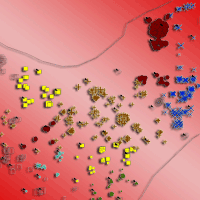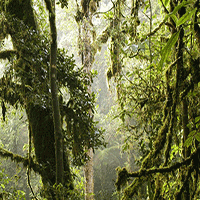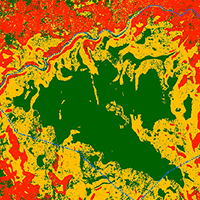
A new zoning index for detecting areas of biological importance applied to a temperate forest in Central Mexico
Alin Nadyely Torres-Díaz, Manuel de Jesús González-Guillén , Héctor Manuel De Los Santos Posadas, Patricia Hernández De La Rosa, Aurelio León Merino
iForest - Biogeosciences and Forestry, Volume 16, Issue 4, Pages 253-261 (2023)
doi: https://doi.org/10.3832/ifor4111-016
Published: Aug 31, 2023 - Copyright © 2023 SISEF
Research Articles
Abstract
Biodiversity conservation is a priority because it is the cornerstone of ecosystem services and natural cycles, providing essential resources for the development of humans and other species. Several indices have been proposed to prioritize areas needing protection. However, some require specific information while others are based on subjective categorical variables, are limited to a particular plant community or cannot be represented at a spatial scale. We developed an Index of Importance for Biological Conservation (InICoB), which was applied to a temperate forest in central Mexico but can be used for any plant community by adjusting some of its parameters. The proposed index is objective, based on quantitative indicators of vegetation composition and structure, and can be spatially projected. InICoB was tested and validated on a temperate cloud forest (CF) and its associated communities: advanced secondary vegetation (ASV) / coffee plantations (CP), agriculture, and induced grasslands. Life forms, presence of endemic, climax, native and protected species, diversity, structural complexity, and complementarity were used as indicators in its construction. InICoB was calculated for 63 sampling units (SUs), and a geostatistical model was incorporated for its interpolation with environmental and social variables as predictors. The results show that InICoB adequately evaluated the different environmental units that cover the locality. Significant differences were observed between the forest and the secondary/induced vegetation. The highest value of InICoB (0.91) was found in the CF, and the lowest in induced vegetation (0.3). The geostatistical model showed that occupation of the land, distance to town, and slope have an important influence on InICoB. The advantages of InICoB include the use of quantitative indicators that can be applied to any plant community. Additionally, it is flexible with respect to the data collected, it can be calculated only with the presence/absence of species or it can include forest measurement data. Furthermore, it is easy to interpret and can be spatially represented in a raster layer that can be added to a geographic information system. Therefore, it can be a very helpful tool in decision-making for land use planning and evaluation of the effects of human activities on plant communities.
Keywords
Biodiversity Conservation, Composition and Structure, Plant Communities, Flora Indicators, Flora Diversity, Cloud Forest, Geostatistical Model
Authors’ Info
Authors’ address
Manuel de Jesús González-Guillén 0000-0003-1814-4320
Héctor Manuel De Los Santos Posadas 0000-0003-4076-5043
Patricia Hernández De La Rosa 0000-0001-8577-1127
Aurelio León Merino 0000-0002-0885-5084
Colegio de Postgraduados, km. 36.5 Carr. Mexico-Texcoco, Montecillo, Texcoco, C.P. 56230 (Mexico)
Corresponding author
Paper Info
Citation
Torres-Díaz AN, González-Guillén MJ, De Los Santos Posadas HM, Hernández De La Rosa P, León Merino A (2023). A new zoning index for detecting areas of biological importance applied to a temperate forest in Central Mexico. iForest 16: 253-261. - doi: 10.3832/ifor4111-016
Academic Editor
Marco Borghetti
Paper history
Received: Apr 08, 2022
Accepted: Jul 04, 2023
First online: Aug 31, 2023
Publication Date: Aug 31, 2023
Publication Time: 1.93 months
Copyright Information
© SISEF - The Italian Society of Silviculture and Forest Ecology 2023
Open Access
This article is distributed under the terms of the Creative Commons Attribution-Non Commercial 4.0 International (https://creativecommons.org/licenses/by-nc/4.0/), which permits unrestricted use, distribution, and reproduction in any medium, provided you give appropriate credit to the original author(s) and the source, provide a link to the Creative Commons license, and indicate if changes were made.
Web Metrics
Breakdown by View Type
Article Usage
Total Article Views: 18460
(from publication date up to now)
Breakdown by View Type
HTML Page Views: 14700
Abstract Page Views: 1984
PDF Downloads: 1470
Citation/Reference Downloads: 4
XML Downloads: 302
Web Metrics
Days since publication: 845
Overall contacts: 18460
Avg. contacts per week: 152.92
Citation Metrics
Article Citations
Article citations are based on data periodically collected from the Clarivate Web of Science web site
(last update: Mar 2025)
(No citations were found up to date. Please come back later)
Publication Metrics
by Dimensions ©
Articles citing this article
List of the papers citing this article based on CrossRef Cited-by.
References
Riqueza y composición florística de pteridobiontes en bosque mesófilo de montaña y ambientes asociados en el centro de Veracruz, México [Richness and floristic composition of pteridobionts in cloud forests and its associated environments in central Veracruz, Mexico]. Revista Mexicana de Biodiversidad 85 (2): 491-501. [in Spanish]
CrossRef | Gscholar
Patterns of structure and diversity across a tropical moist forest chronosequence. In: Proceedings of the “IAVS Symposium”. Opulus Press, Sweden, pp. 237-241.
Gscholar
Las plantas vasculares del bosque mesófilo de México [Vascular plants of the cloud forest of Mexico]. In: “Los Bosques Mesófilos de Montaña de México, Diversidad, Ecología y Manejo” (Gual-Díaz M, Rendón-Correa A eds.). CONABIO, México, pp. 189-195. [in Spanish]
Gscholar
Patrones espaciales de cambio de cobertura y uso del suelo en el área cafetalera de la Sierra Norte de Puebla [Spatial patterns of land cover change and land use in the coffee zone in the Sierra Norte of Puebla]. Investigaciones Geográficas 72: 23-38. [in Spanish]
Online | Gscholar
Efecto de la orientación y la altitud sobre la heterogeneidad vegetacional en el Cerro Verde, Nizanda (Oaxaca), México [Effect on vegetation heterogeneity of the orientation and altitude in Cerro Verde, Nizanda (Oaxaca), Mexico]. BSc thesis, Facultad de Ciencias, Universidad Nacional Autónoma de México, México. pp. 79. [in Spanish]
Gscholar
Los bosques mesófilos de montaña en México [Mountain cloud forests in Mexico]. In: “Los Bosques Mesófilos de Montaña de México, Diversidad, Ecología y Manejo” (Gual-Díaz M, Rendón-Correa A eds.). CONABIO, México, pp. 27-68. [in Spanish]
Gscholar
Forest environments in tropical life zones: a pilot study. Pergamon Press, UK, pp 747.
Gscholar
Síntesis geográfica del estado de Puebla, México [Geographical synthesis of the state of Puebla, Mexico]. Instituto Nacional de Estadística, Geografía e Informática - INEGI, México, pp. 121. [in Spanish]
Gscholar
Montane cloud forests. In: “Encyclopedia of the World’s Biomes” (Goldstein MI, DellaSala DA eds). Elsevier, USA, Vol. 3, pp. 138-145.
Gscholar
Manual de herbario: administración y manejo de colecciones, técnicas de recolección y preparación de ejemplares botánicos [Herbarium manual: administration and management of collections, collection techniques and preparation of botanical specimens]. Consejo Nacional de la Flora de México, México, pp. 142 [in Spanish]
Gscholar
Atributos ecológicos y de hábitat de las especies suculentas del área natural protegida monumento natural Yagul, Oaxaca, México [Ecological and habitat attributes of succulent species in the natural monument of Yagul, natural protected area, Oaxaca, Mexico]. Botanical Sciences 98 (1): 36-49. [in Spanish]
CrossRef | Gscholar
Flora útil de los cafetales en la Sierra Norte de Puebla, México [Useful flora of coffee plantations in the Sierra Norte de Puebla, Mexico]. Revista Mexicana de Biodiversidad 78 (1): 15-40. [in Spanish]
Gscholar
Environmental assessment of climate of a habitat through floristic life-form spectra, a case study of Warangal north forest division, Telangana, India. Journal of Natural Sciences 2 (1): 77-93.
Gscholar
Un índice de evaluación de la vegetación con fines de conservación en áreas privadas de los Llanos del Orinoco, Venezuela [A vegetation evaluation index for conservation purposes in private areas of the Llanos del Orinoco, Venezuela]. Interciencia 31 (2): 130-135. [in Spanish]
Gscholar
Indicadores ecológicos que evalúan el estado de antropización-conservación de las formaciones vegetales, ecosistemas, paisajes y territorios [Ecological indicators that assess the anthropization-conservation state of plant formations, ecosystems, landscapes and territories]. Acta Botanica Cubana 215 (3): 328-335. [in Spanish]
Gscholar
Factores físicos que influyen en las relaciones florísticas de los piñonares (Pinaceae) de San Luis Potosí, México [Physical factors that influence on the floristic relationships of pine nuts (Pinaceae) in San Luis Potosí, Mexico]. Revista de Biología Tropical 62 (2): 795-808. [in Spanish]
CrossRef | Gscholar
NOM-059-SEMARNAT-2010, Protección ambiental - Especies nativas de México de flora y fauna silvestres - Categorías de riesgo y especificaciones para su inclusión, exclusión o cambio [Environmental protection-Native species of wild flora and fauna of Mexico - Risk categories and specifications for their inclusion, exclusion or change]. Diario Oficial de la Federación, Mexico, web site. [in Spanish].
Online | Gscholar
El bosque húmedo de montaña en México y sus plantas vasculares [The moist montane forest in Mexico and its vascular plants]. CONABIO - UNAM, México, pp. 38. [in Spanish]
Gscholar
La fragmentación del bosque mesófilo de montaña y patrones de uso del suelo en la región oeste de Xalapa, Veracruz, México [Mountain cloud forest fragmentation and land use patterns in the western region of Xalapa, Veracruz, Mexico]. Madera y Bosques 8 (1): 73-89. [in Spanish]
CrossRef | Gscholar

